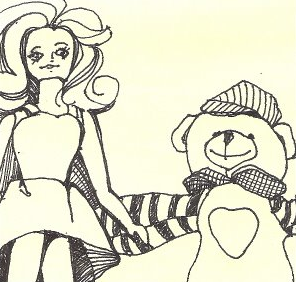
I enjoyed reading David Beronä’s book, Wordless Books: The Original Graphic Novels (2008), which describes (with select examples) the work of early-20th century woodcut storytellers such as Frans Masereel and Lynd Ward. Beronä makes glancing suggestions that these initially small publications (descended from block-books and playing cards) are the missing link between the cinema and modern day graphic novels. “When Thomas Mann,” he writes, “winner of the Nobel Prize for Literature in 1929, was asked what movie had made the greatest impression on him, Mann replied, ‘Passionate Journey.’ Although Mann’s reply sounds like the title of a film by D. W. Griffith, it was, in fact, a novel in woodcuts by Frans Masereel.”
Beronä contends that the prevalence of German expressionist woodcuts, the popularity of silent film (in particular its heroes like Chaplin, and visual achievements like The Cabinet of Dr. Caligari and The Last Laugh), and the rise of political cartoons in newspapers set the stage for the woodcut novel. Beronä writes: “For a public already familiar with black-and-white pictures that told a story, worldess books offered the public, in one sense, silent cinema in a portable book that they could ‘watch’ at their leisure.”

Fittingly, the German publisher of Masereel’s 1920 The Idea (83 woodcuts visualizing an idea as a naked woman enraging elites but inspiring the masses) commissioned an animated adaptation. He turned to Berthold Bartosch, the Czech-born Berlin filmmaker who created many of the atmospheric effects in the world’s first animated feature, Lotte Reiniger’s brilliant The Adventures of Prince Achmed (1926). Bartosch was not only a perfect artistic and technical choice, like Masereel (who was a member of the Red Cross and the international pacifist movement during World War I) he was a leftist who counted among his friends Reiniger, Carl Koch, Jean Tedesco, and Jean Renoir.

Bartosch emigrated to Paris in 1930, where he created his 25-minute adaptation, also entitled The Idea (1932), which his future friend and colleague (and brilliant animator in his own right) Alexander Alexieiff called “the first serious, poetic, tragic work in animation.” (The film is also noted for Arthur Honegger’s score, which is thought to be the first to utilize an electronic instrument, the ondes Martenot.) Alexieiff’s statement is no hyperbole: Bartosch’s film, with its adagio pacing, multiple layers of foggy (actually soapy) luminescence, and evocative urban detail, is a stunning achievement even today. Not content with simply animating the woodcuts (even if that were possible), Bartosch constructed an original vision that draws directly from Masereel’s imagery but re-envisions it as moving graphic illustrations extracted into deep space, its detailed cityscapes, swirling atmosphere, and dramatic superimpositions fusing together fantasy and reality. Appropriately for a film based on a “worldless book,” Bartosch shuns the use of intertitles except for a brief prologue extolling the durability of ideas.
From 1935 to ‘39, Bartosch worked on an epic anti-war film, but according to Robert Russett and Cecile Starr (who shares the copyright with Bartosch’s widow on The Idea’s 1976 print) in their seminal book, Experimental Animation, “about 2,000 feet of film had been shot when Bartosch and his wife were forced to flee Paris at the time of the Nazi occupation. All negative and positive material of the uncut film was deposited in a vault of the Cinémathèque Française; none of it was found again. Only a few test strips were saved…”
Alexeieff picks up the story in an interview reprinted in the book:
“When I had to leave Paris in 1941, I gave Bartosch up for lost. The occupation of the Sudentenland had made him a German. The Nazis were aware that Bartosch had refused their passport, that during his Viennese period he had worked on films on Thomas Masaryk’s theses, and that he had begun an anti-Nazi film as propaganda against Hitler (1938). [Physically] lame as he was, not knowing how to speak French, he was far too distinctive and vulnerable to escape being quickly spotted.
When I saw him again in 1947 on the Boulevard St. Germain, and when I greeted him in German, with my Russian accent, he answered me in French: ‘Now I don’t spik Cherman anymore, I spik Franch.’ I asked about his film. ‘When they came to look for me,’ he told me, ‘they didn’t find me, but they found my film and they destroyed it.’
He planned to make a third film, a film still more grandiose, on the Cosmos. During the twenty last years of his life, he set about putting together all the details of this new film, whose secret he carried to his grave, November 13, 1968. . . . The destruction of the second film had been too hard a blow, even for Bartosch’s will of iron. He never complained about it, but I think that for the rest of his life he merely played with the idea of resuming his creative film work, while doubting his power to bring back to life what the war had crushed.”
* * * *
One final note: in searching for an online version of Bartosch’s film, I came across Short Animated World, an excellent website that links many online versions of the titles chosen for Annecy Festival’s 2006 “100 Films for a Century of Animation” created by a worldwide poll of thirty specialists. Some of the links have been removed, but most of them remain, and are well-worth clicking through. The Idea comes in at ninth place. As you might expect, the films get less canonical the further down the list they appear, but most are still worth your time. The links tend to be unsubtitled versions of the films, but in many cases this is only a minor hurdle.
Among my personal (and available) favorites:
004 Crac! (Frederic Back)
005 The Man Who Planted Trees (Frederic Back)
006 Tale of Tales (Yuri Norstein)
008 A Color Box (Len Lye)
010 The Street (Caroline Leaf)
018 Tango (Zbigniew Rybczynski)
020 Begone Dull Care (Norman McLaren)
023 Father and Daughter (Michael Dudok de Wit)
025 The Hand (Jiri Trnka)
027 The Nose (Alexandre Alexeieff and Claire Parker)
031 The Cameraman’s Revenge (Ladislaw Starewicz)
036 Composition in Blue (Oskar Fischinger)
041 Free Radicals (Len Lye)
042 The Ride to the Abyss (Georges Schwizgebel)
044 Franz Kafka (Piotr Dumala) . . . although I definitely prefer Dumala’s Crime and Punishment
046 Two Sisters (Caroline Leaf)
048 Balance (Christoph and Wolfgang Lauenstein)
049 Hedgehog in the Fog (Yuri Norstein)
050 When the Day Breaks (Wendy Tilby and Amanda Forbis)
051 Rooty toot toot (John Hubley)
054 Frank Film (Frank Mouris)
057 Mindscape (Jacques Drouin)
058 Jumping (Osamu Tezuka)
060 The Wrong Trousers (Nick Park)
063 Fast Film (Virgil Widrich)
066 Ryan (Chris Landreth)
070 Mt. Head (Koji Yamamura)
073 The Sinking of the Lousitania (Winsor McCay) . . . in spite of its flagrant warmongering
. . . the Kentridge and Borowczyk films should be seen in better quality . . .
 Wednesday, November 3, 2010 at 6:47AM
Wednesday, November 3, 2010 at 6:47AM 
 I love children's books. While I have yet to have any children, I have a small but growing collection of books that will absolutely be read to any children that I might have one day. In the meantime, I enjoy these myself.
I love children's books. While I have yet to have any children, I have a small but growing collection of books that will absolutely be read to any children that I might have one day. In the meantime, I enjoy these myself.














